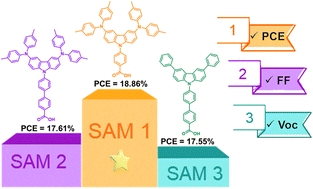Influence of the carbazole moiety in self-assembling molecules as selective contacts in perovskite solar cells: interfacial charge transfer kinetics and solar-to-energy efficiency effects
The use of self-assembled molecules (SAMs) as hole transport materials (HTMs) in p-i-n perovskite solar cells (iPSCs) has triggered widespread research due to their relatively easy synthetic methods, suitable energy level alignment with the perovskite material and the suppression of chemical defects. Herein, three new SAMs have been designed and synthesised based on a carbazole core moiety and modified functional groups through an efficient synthetic protocol. The SAMs have been used to understand the SAM/perovskite interface interactions and establish the relationship between the SAM molecular structure and the resulting performance of the perovskite-based devices. The best devices show efficiencies ranging from 18.9% to 17.5% under standard illumination conditions, which are very close to that of our benchmark EADR03, which has been recently commercialised. Our work aims to provide knowledge on the structure of the molecules versus device function relationship. The linker and the terminal functional groups of SAMs based on the carbazole core play an important role in the efficiency of inverted perovskite solar cells.

González, D. A.; Galvis, C. E. P.; Li, W. H.; Méndez, M.; Aktas, E.; Martínez-Ferrero, E.; Palomares, E.
Nanoscale Adv. 2023
DOI:
10.1039/d3na00811h

Let's create a brighter future
Join our team to work with renowned researchers, tackle groundbreaking
projects and contribute to meaningful scientific advancements




















